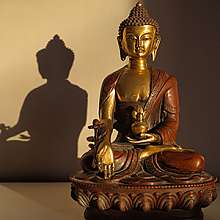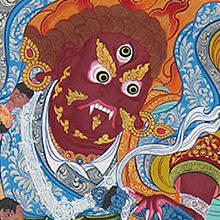Pilgrimage Letter
Dear community,
Recently, a letter from a small group of students who organized a pilgrimage to Nepal (March 2020) to practice with the Sakyong was circulated among some Shambhala members. In it, they voiced their views about the relationships between Shambhala, the Sakyong, and his students. This group was organized outside of any official Shambhala institution or group and, therefore, does not claim to represent any official view or knowledge of the Shambhala organization, its leadership or its community. If you would like to read the Pilgrimage Letter, you can find it below. As this letter touches on complex issues about Shambhala, you may wish to reach out to your meditation instructor or a Shambhala teacher to support you in understanding the contexts of the issues raised in the letter. You may choose to contact the Center manager, Joshua Raen Thornberry (manager[at]berkeleyshambhala[dot]org) or Meditation Instructor Jon Ransohoff (jlr00721[at]pacbell[dot]net) if you want help in connecting with someone to assist you with this.
~~~~~~~~~~~~~~~~~~~~~~~~~~~~~~~~~~~~~~~~~~~~~~~~~~~~~~~
14 May 2020
Dear Fellow Students of Sakyong Mipham Rinpoche,
In gatherings and personal conversations since the pilgrimage to visit the Sakyong and Sakyong Wangmo in March, we have heard many questions from you about how the Sakyong wishes to move forward with his students and with the Shambhala organization, and about the current situation and recent turmoil in Shambhala. This letter is an attempt to share our understanding of the Sakyong’s views, based on his public communications and our private discussions with him. Our aspiration is for this letter to bring clarity and faith, and to allow us to move forward at this difficult time in our community, when there are doubts regarding the Sakyong as well as the nature and identity of the Shambhala organization.
We have had the good fortune to meet with the Sakyong personally over the past two years, and to support teaching activities such as the recent Nepal pilgrimage. Throughout our recent service, we have had ongoing formal and informal communication with the Sakyong, allowing us to offer our current understanding of his views and intentions to fellow students. We offer this letter as devoted students dedicated to furthering the Sakyong lineage, not as official representatives. We have done our best to communicate our understanding accurately.
First, regarding his own past conduct, in his letters to the community the Sakyong has apologized repeatedly for any past actions that led to individuals feeling hurt in any way. He has also met with several people to apologize personally. It may not be widely known that since autumn 2018 he has had meetings with over 150 students to listen to their feedback and to hear their experiences of misconduct, sexism, and inequality in the Shambhala community. While much work has already been done, the Sakyong recognizes the need for additional change within Shambhala. He is supportive of the new care and conduct policies being developed, and does not condone any kind of sexual abuse or inappropriate relations between teachers and students or between anyone else within the Shambhala mandala.
At the same time, it is our understanding from published reports of the investigations and from private conversations that many of the allegations reported about the Sakyong were exaggerated or completely false. If someone felt hurt or confused by their relationship with him, he has done his best to address their concerns personally. Over the years, the Sakyong made many personal changes in his own life, married the Sakyong Wangmo, and started a family. As individuals who have served the Sakyong closely in recent years, we have personally experienced the wholesomeness of the Kalapa Court as a place of family, practice, and training guided by the Sakyong and the Sakyong Wangmo.
The Sakyong is keenly aware of the confusion and pain in the community, and holds Shambhala’s students in his heart and practice while on solitary retreat, during his daily practice, and in regular pujas with his family in Nepal. The Sakyong and the Sakyong Wangmo have been reading the many letters sent to them and receive regular updates from students and leaders. They are aware of the different viewpoints and opinions circulating in the community as well as the general uncertainty about how to go forward. Recently, out of care and concern for the effects of the pandemic on students, the community, and the world, the Sakyong composed practice instructions for this time. In response to student supplications, these have been made available to those in the community who wish to practice them.
In recent teachings and public communications, the Sakyong has been clear that the path for the community to collectively heal is to strengthen our connection to the Shambhala teachings through practice. He has shared that in the face of widespread confusion in the world and our own community, it is by practicing the dharma that we can connect with our own wisdom and compassion and be of benefit to others. In this way, faith in the dharma and the lineage becomes the guiding principle binding us as a community. The Sakyong has also shared that he will do his part to help facilitate healing by teaching and connecting with students in a gradual and organic manner.
With respect to his relationship to the Shambhala organization, we want to highlight that in summer 2018, the Sakyong volunteered to temporarily step back from teaching and administrative duties in order to support the independent investigation into the allegations against him. He was later asked to step back from teaching “for the foreseeable future” by the acharyas and others, and the financial support traditionally provided by the Shambhala organization to the lineage was discontinued. Soon after that, due to increasing concerns about their family’s safety, financial considerations, and unique opportunities for their daughters’ spiritual education, the Sakyong and the Sakyong Wangmo relocated to Asia, where the Sakyong began a series of solitary retreats.
While in retreat, the Sakyong continued to receive supplications from students to teach and bestow empowerments such as the Rigden Abhisheka. In October 2019 he was invited to bestow the Rigden Abhisheka by Dechen Chöling. This invitation was supported by the Shambhala Board as a single teaching event. Other than this, the Sakyong has not been invited by the organization to resume his traditional teaching and leadership activities. Although not directly involved in the organization, he has given his support to the Shambhala Board through ongoing communication and has met with them several times at their request.
The Sakyong is aware that some members of the Shambhala community may not wish for him to resume his duties as a teacher or leader, or are unclear about Shambhala’s identity and the place of the lineage within the organization. He has pointed out that this is a long-standing issue for some students in our community, as many have misunderstood the function and importance of lineage and its relationship to the organization. Although the Shambhala organization was established to support the activities of the lineage, this motivation became less obvious as the community grew and expanded. Many began to believe that Shambhala was just a loosely affiliated secular community inspired by the Shambhala teachings and general Buddhism rather than an organization and community based on the teachings and guidance of the lineage of Sakyongs.
In fact, the centrality of lineage to Shambhala is the defining characteristic of Shambhala’s purpose as a non-profit organization. This was explained in a recent newsletter from Shambhala Europe and is also reflected in Shambhala’s articles of incorporation, which state that the purpose of the organization is to support and facilitate the teachings of the Sakyong lineage of Shambhala under the leadership of the Sakyong.
From the perspective of our history, the teaching of both Sakyongs, and Buddhism in general, Shambhala has always been a lineage-based rather than a community-led organization. It is this distinction that needs to be clarified. While giving space to the leadership and the community, the Sakyong has shared that in terms of going forward, it must be understood that the Shambhala organization is based on the spiritual teachings of the lineage under the guidance of the living lineage holder, for that living lineage-holder maintains the integrity of the terma and the buddhadharma through an unbroken line of transmission. These transmissions form the basis of the practice path of any student in Shambhala, from the initial meditation instruction and teachings on basic goodness onward. It is this lineage of transmission that the Sakyong has vowed to protect, propagate, and pass on to future generations of family lineage holders and devoted practitioners.
Although there is some uncertainty in the community regarding the relationship between the lineage and the organization, the Sakyong continues to teach, meet and communicate with students. He has made it clear that he will always be there as a teacher for his students and that he is willing to teach when supplicated. For the time being, these teachings, and the communications about them, have been taking place outside of the organization. We understand that communications about these activities, while well-intentioned, have not reached all those who may have wished to hear about them. The Sakyong is aware that there are many students who wish to see him who haven’t been able to do so. He remains committed to bestowing the Rigden Abhisheka at Dechen Chöling and to offering further teachings as soon as the global pandemic allows.
We hope that sharing this view and perspective is helpful for you. As fellow students of the Sakyong, we feel that the Sakyong lineage is central to all aspects of Shambhala. There is no Shambhala without the Sakyong. During this time of uncertainty, we aspire to continue to support the Sakyong’s teaching activities either inside or outside of the organization. Inspired by the simplicity of the teacher-student relationship, we hope to create situations where the Sakyong can connect with students in a genuine way.
If you know of someone who would benefit from reading this letter, please feel free to share it with them.
Sincerely,
The Nepal Pilgrimage Planning Group








